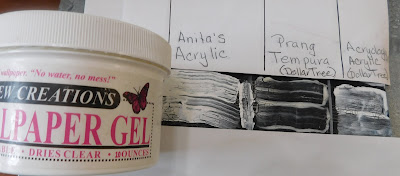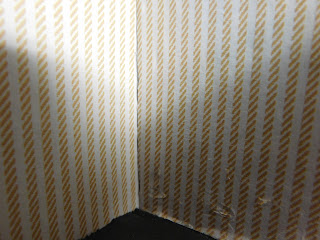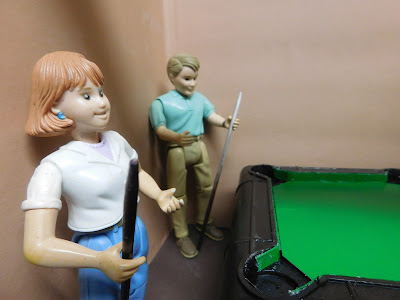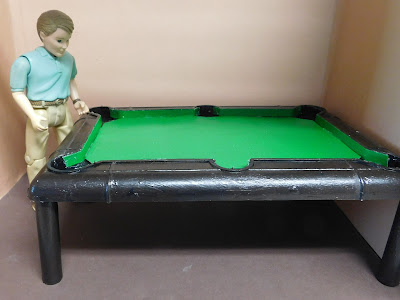This week I decided to do another paint test, this time I wanted to test some of the DIY options for crackle medium. If you have watched my channel for very long you probably have figured out I love to age things. I would much rather make something look like it has been around for a while and maybe not taken the best care of than to make stuff that looks like it just came from the store. I love how aged items add so much character to our mini worlds and help to tell the story of life.
That being said I have used a lot of crackle medium on the channel. But there have been way too many times in my crafting history that I have purchased a bottle of crackle medium, used a tiny bit of it then put the bottle away. Then the next time I want to use it one of two things probably happens either I can’t remember where I put it, or I know where it is only to find it has dried up and is no longer usable. I have wondered about some of the DIY solutions for a while but I wasn’t sure which one I wanted to try. So today I am testing a few of those options.
I did limit today’s test to alternatives that are all water based and things most of us doing dollhouse miniatures have on hand.
To set up the test I fist had to pick a surface to work on. I decided to use a sheet of 140 lb watercolor paper. I chose this because I wanted to do the test in such a way that I would end up with basically a chart that I could put in the tub with my craft paints to refer to later. The watercolor paper is very stiff and made to paint on. I was able to coat almost the entire page with multiple coats of liquid and there is no warping at all. I am also confident that my resulting chart will hold up to being tossed in the paint bin and not become overly damaged.
Since I wanted to have the best (most dramatic) contrast to show off the crackling I painted the work area of the chart with black craft paint. With the plan to use white as my top coat.
At first I was going to just use white craft paint (Anita’s Acrylic) but decided to add 2 of the paints I purchased at Dollar Tree (Prang Tempura and Acryology Acrylic) just to see what would happen with them. After all I have them in my stash and I would love to find some use for them.
As for the things we are testing to use as a DIY crackle medium- white glue (Elmer's school glue), Tacky glue (both as it comes and diluted), Mod Podge (mat and gloss), and dollhouse miniature wallpaper gel.
I tried to do my best to do each product the same way to give fair results. I did end up having to hurry the process along as the day went on because I simply ran out of time. This test took all day. I started trying to let each test dry before I went to the next one but that just wasn’t going to work since I only had a limited time to do this. So the ones toward the end didn’t get as much time.
I used my Mod Podge Squeegee to apply all (except the wallpaper gel) to the paper.
After these had a chance to set up a bit I used clean brushes to apply the paints over in each section.
So let’s look at each of the tests and see the results.
Elmer's School Glue: Elmer’s glue is probably the most commonly used product for this purpose so I started with it. I have had mixed results in the past. In the test it worked really well with the Anita’s paint. The Prang paint did give an interesting texture but it is not a crackle by any means. I didn’t really see much effect on the dollar store acrylic paint though.
Tacky Glue: I saw a lot of people saying not to use Tacky glue for this but no one said why. I decided to try it to see for myself how/if it would work. I have to say I love the way it worked with the Anita’s paint, it gave nice cracks that look very rustic. Some oar a bit large for mini objects but they look great and I will probably be using this for some projects in the future. The Prang paint really didn’t do much (again) but the dollar store acrylic paint has an almost lacy patter to it. I think this is combo is something I am going to play with off camera to see what I can do with it because I see some potential here.
Diluted Tacky glue: since tacky glue is much thicker that the white glue I decided to try it diluted with some water also. This gave some interesting results. In the spots where I had a thicker coverage the Anita’s paint has a nice crackle pattern. In the really thin areas it didn’t really do anything. The dollar store acrylic paint again has an almost lacy pattern to it which I am finding really interesting and frankly really pretty.
Mat Mod Podge: I saw a couple of tutorials online using Mod Podge as a crackle medium and all of them used the mat variety. The big difference in those tutorials from the ones using the white glue was they all put the paint over the Mod Podge much sooner so that is what I did also. I really don’t see much in the way of crackling with this and I wonder it if is just not a good option or should I have waited longer?? If I have time in the next few weeks I might try it again and see if I can test different times to see if I can get it to work better. That being said I have tried to use Mod Podge in the past as a crackle medium without success.
Gloss Mod Podge: every single tutorial I saw using Mod Podge as a crackly medium used mat and not any of the other varieties. That is not to say that there were none out there just none in the several I watched. I did this test the same as the I did with the mat and really got the same results. I did find however that for whatever reason the gloss variety dried much faster on my test surface that the mat did.
Dollhouse Miniature Wallpaper Gel: this was the test I was most excited about and I am very happy with the results. I did add most of the paint way too soon. If you look at the area at the right side of the box where the Anita’s paint is there is a bit of paint that was brushed on vertically, this I added an hour or more later when the gel started to get more tacky and the crackles in that part are really nice. I did find the gel took forever to dry, it was still a long way from dry when I checked it just before I went to bed and that was hours later. At that point I did hit it with my heat gun just a bit to see if I could get any crackling because at that point I wasn’t seeing much. After some heat I saw a few cracks starting but I also got a bit of bubbling. I only directed the heat at the the Anita’s part of the test but I am thinking that it also heated up the center (Prang) section also because I do see a few cracks in that area too. The part that really pleases me is the dollar store acrylic paint has some wonderful small cracks with the gel and the overall pattern of those cracks is very attractive. So this is another one that I think I will be playing around with to see what I can get it to do.
After getting through this test I have more ideas of other products I would like to try to see if they would work as crackle mediums so I will probably be doing another DIY crackle medium video in the future.
As always I do want to sincerely thank all of you for watching my videos and reading my blog posts. It means so much to me that you are supporting me in this way. If I could ask you all to do just a bit more by subscribing to the channel and liking the videos and leaving comments. Those help more than you can imagine. Also if you could pass the links on to your friends I would appreciate it so much.














































